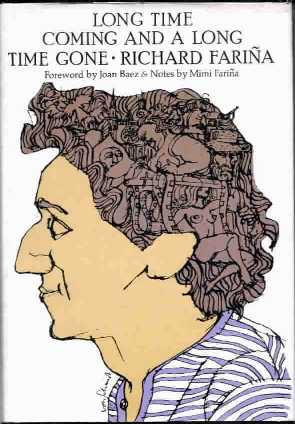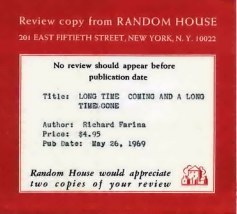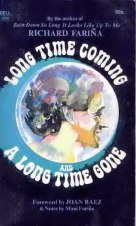The Fariña Files | home
Been Down So Long It Looks Like Up To Me | Been Down So Long - The Epic Film! | Long Time Coming And A Long Time Gone | College Hijinx
Long Time Coming And A Long Time Gone
The cloth edition was put out by Random House on May 26th, 1969, at $4.95. It carried a six-page foreword by Joan Baez, which she also featured in her autobiography, Daybreak (1968), and in an Esquire magazine article (1966) entitled "Introduction to -and Conclusion of - a Future Hero". The book gets generally good reviews, though reaction to some of the individual works is mixed. Harry S. Resnik comments in his Saturday Review article "Fariña was a brilliant posturer and a vibrant personality, yet his best work surviving him is his songs. One
reaction to some of the individual works is mixed. Harry S. Resnik comments in his Saturday Review article "Fariña was a brilliant posturer and a vibrant personality, yet his best work surviving him is his songs. One  realizes after reading this book that as a writer of prose he never found a voice of his own." But he also states, " His life was an intensely colorful and eclectic life while it lasted, a continual assertion of individuality and creative strength... he was relentlessly articulate."
realizes after reading this book that as a writer of prose he never found a voice of his own." But he also states, " His life was an intensely colorful and eclectic life while it lasted, a continual assertion of individuality and creative strength... he was relentlessly articulate."
 reaction to some of the individual works is mixed. Harry S. Resnik comments in his Saturday Review article "Fariña was a brilliant posturer and a vibrant personality, yet his best work surviving him is his songs. One
reaction to some of the individual works is mixed. Harry S. Resnik comments in his Saturday Review article "Fariña was a brilliant posturer and a vibrant personality, yet his best work surviving him is his songs. One  realizes after reading this book that as a writer of prose he never found a voice of his own." But he also states, " His life was an intensely colorful and eclectic life while it lasted, a continual assertion of individuality and creative strength... he was relentlessly articulate."
realizes after reading this book that as a writer of prose he never found a voice of his own." But he also states, " His life was an intensely colorful and eclectic life while it lasted, a continual assertion of individuality and creative strength... he was relentlessly articulate."
The cover illustration was by Eric Von Schmidt from the David Gahr photo (which graced the back cover); Eric said he was having a lot of trouble getting the likeness until he added the slight grin.
It went through two printings in hardcover.
I have never seen the book with a numbering sequence that starts with 1, so will guess, along with every book dealer I've ever talked to, true first printings have a numbered sequence backwards from 9 to 2, with "First Printing" above it. Even  reviewer's copy I have says the same thing. I've only ever seen one second printing, and that included the 9-2 numbering sequence, but without the "First Printing" above it.
reviewer's copy I have says the same thing. I've only ever seen one second printing, and that included the 9-2 numbering sequence, but without the "First Printing" above it. 
 reviewer's copy I have says the same thing. I've only ever seen one second printing, and that included the 9-2 numbering sequence, but without the "First Printing" above it.
reviewer's copy I have says the same thing. I've only ever seen one second printing, and that included the 9-2 numbering sequence, but without the "First Printing" above it. 
One nice touch was the embossing of Fariña's signature on the cloth cover.

It was out of print within two years, as far as I remember.
The paperback was done by Dell Publishing Co., and came out a year later in May, 1970 at ninety-five cents and seems to have gone through only one printing, on cheap paper which turned yellow practically overnight. It has never been reissued. The cover is an anonymous watercolor and ink, again done from the Gahr photo, this time flipped backwards, with the artist using the same collage in the hair motif as Von Schmidt.

Obviously, the front.
Obviously, the back. 

Random House promo disc
In May of 1969, a year after Vanguard released the Memories album , Random House published Long Time Coming And A Long Time Gone. Figuring there might be a Fariña wave to be caught, the marketing people at Random House came up with a fairly novel way at the time (a prehistoric relic of the massive audio-cassette-as-promo biz) to get the word out on a book which already had a waiting audience. A promotional album was produced by them, probably 100 pressed, given the number "Richard Farina ANCL A/B 2013", and sent out god knows where - radio stations and reviewers are likely - and promptly vanished from memory, even Random House's writer and producer, Michael Friedman only vaguely recalled having done it. Until June of 2001, none were glowing in a vault, circulating or even rumored to exist. The dam broke when ebay offered one for sale, sending wallets flying and Fariñaphiles at all corners of the earth off at a gallop, baying at the moon in search of the elusive LP.
It can now be reported that the LP was issued in a plain white sleeve, with the cataloging information on the cover in ink. It was issued as two fifteen minute radio programs, one per side. The album is in mono and features a narration by one Ed Jordan, with excerpts from the poems and stories in Long Time Coming by one or more anonymous actors. While the narrative is given to phrases like " Richard Fariña - poet ... singer...novelist... dead these three years... has given us another joy...", it's nonetheless interesting to hear, although I don't know that the aforementioned joy is immediately apparent.
It opens with "Pack Up Your Sorrows", pressed down into mono from that odd pressing Vanguard did in the spring of '68 where Dick's voice is way under Mimi's, to the point of being almost inaudible at times. Naturally, that's the one they used. After much puffery about Dick's life and career, the narrator reads an excerpt from Joan Baez's intro to the book. This is followed by a ten second clip from an interview with Mimi, recalling the day she met Dick in Paris ("I was 16 and he was 24... I was very impressed"). The interview with Mimi is completely different from the one she did with Christopher Cerf that was interspersed and used as intros to the various bits in the book; in fact, it sounds as though Mimi was handed a recorder and asked to go somewhere and reel off some quick anecdotes, or give answers to some written questions, and she seems to have done it in public, where breezes and trash trucks can be heard. At one point, she admits, "I'm finding it difficult to talk in this situation.... but I'll continue to try."
In part one, the actor does "The field near the cathedral at Chartres" (over "Miles"), "With a copy of Dylan under my arm" (over "Tommy Makem fantasy"), " The flax long ripe", and "The passing of various lives" . The narrator waxes poetic about Dick leaving home at 18 to travel to Ireland, the "deep influence of Hemingway" (Mimi adds that just after they met, "He went to Pamploma - to live out his Hemingway fantasy") , Dick's trip to Cuba, and defeats the concept of a fact-checker by claiming Fariña dashed to California in 1963, married Mimi Baez and wrote Been Down So Long" in its entirety , although it what order and at what speed he does not say.
Mimi's recollections are a bit less frantic. She says "he left home at 18... he went away to fulfill a dream about being a romantic... and he succeeded, I guess." Mimi adds her observation to the writer's habit of turning what they see, feel or know into literature - Dick, she says, was always making up stories "out of something that happened in his life... if some really far-out event took place, I could usually count on hearing it later in a song or story." She joins the chorus of his friends by saying when they met on a picnic at Chartres, in France in 1963, she found the still-married-to-Carolyn-Hester unemployed writer trying to catch her eye to be " extremely funny... and I really dug him... He was sort of the life of the party, as he always was."
Side two abandons the readings of the works temporarily in favor of more interviews and songs. It opens with a Mimi memory about Dick's plans for the future : "I remember Dick telling me as we walked... he wanted to be known as an artist - because that included a writer, singer, and a painter - as an artist." The narrator then rings in with a plug for the book, as "V." plays in the background. Mimi returns with further comments on Dick's fascination with "making it" and the fame he hoped to find : "He very much wanted fame... It didn't concern him much at first - Joannie used to tell him it wasn't so much...", and Joan had explained to him that fame was fun and he could glory in it and enjoy it, but shouldn't get caught up in it. "He always wanted people to know his name." Absent from these recollections, and possibly just as interesting, are Mimi's feelings about "making it" and the measure of fame performing was to bring her as well as Dick. I gather interviewers at the time rarely asked Mimi about Mimi. I saw her play in Philadelphia at the Bijou in April of 1982, and was backstage when a stranger, unfamiliar with her beyond her just-finished performance, complemented her spontaneously and abundantly and was rewarded in kind with a joyous hug. I gathered this didn't happen often enough.
"Quiet Joys of Brotherhood" and "Joy Round My Brain" (again with Dick's vocal almost missing in the recording) play while the narrator gives some biographical embellishments about the two living in a small cabin in Carmel, California, near her sister Joan, and the earliest days together as "Dick and Mimi" and the formation of their act together. Mimi recalls the days as "absolutely mad - it was one dashing day to the next." After "living in the west for a year", practicing together while Dick wrote his book and Mimi danced, they moved to the east coast. "We made a record right off the bat, before we'd even played anywhere!" Their life at the time was centered in Cambridge, Mass. and consisted of Dick writing all week, with the weekends free to perform, ( "We played on weekends... driving to New Jersey, Philadelphia, or New York, or Boston")
although they seem to have been spent, to paraphrase McCartney's grandfather, in a room, then a car, then a room, and a room, then a stage and a room, then a car and a room...
In conjunction with the political times they lived in, Mimi discusses Dick's politics, saying " he wasn't a communist or an atheist... he didn't belong to any particular party", and that his philospohy of peace and non-violence was close to her sister Joan's very public pacifism. " He thought changes could be made through different ways than war", and as such, got involved with Joan's Institute For The Study of Nonviolence in 1965. After a narration concerned with how Joan "knew Dick and loved him", Joan's version of "Birmingham Sunday" is played and explained, with the odd disclaimer that " Richard Fariña was no revolutionary!", a claim I'm sure he'd take nonviolent issue with, and one that's plagued pacifists all along (it could almost have been a "Little Nothing poem" - People pretended not to notice, but when out came clubs and threats, pacifists did Nothing and did it in a great, big way...)
Next on the bill of fare is "his good friend Judy Collins" singing her version of "Hard Lovin' Loser" , with narration and a brief return to Side One's form with a reading of some of the "Little Nothing Poems". After the reading, Mimi returns and comments that Dick "talked about himself a lot. He was very mysterious. He would have strange dreams that he would talk about... He believed in luck - a couple of times he told me... he saw a deck of cards and he cut the deck ... and it came up an ace." It's also at this point that Mimi admits to the interviewer - or the machine - she's having trouble with the way the interview is progressing, which as I said before, leads me to think she wasn't talking to anyone, and that under the best of circumstances in 1969 it was hard for her to talk about Dick anyway, and that these certainly weren't her definition of "good" circumstances. And just to make things more uncomfortable, the narrator returns with several pseudo-cryptic comments along the line of " Dick was getting ready to leave...", followed by a reading of "The Good Fortune of Stone".
"Reflections in a Crystal Wind" starts playing and is cited by the narrator as being "the last song Dick and Mimi wrote", followed by another plug for the book and a fade out on the credits.
Ó 2002 Greg Pennell